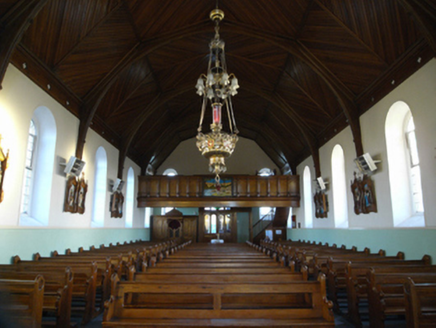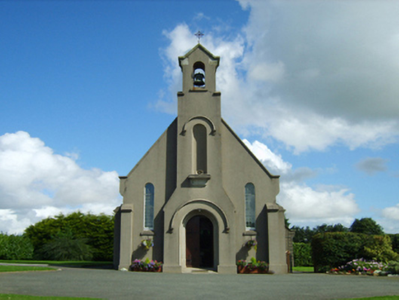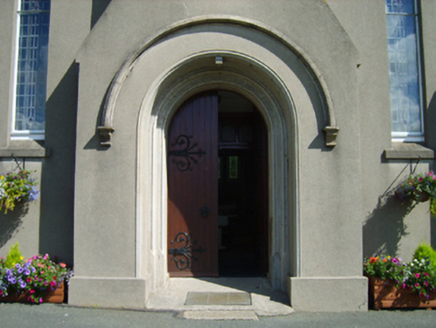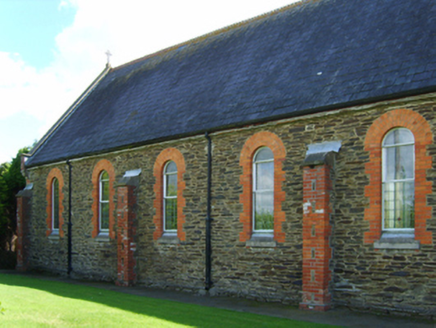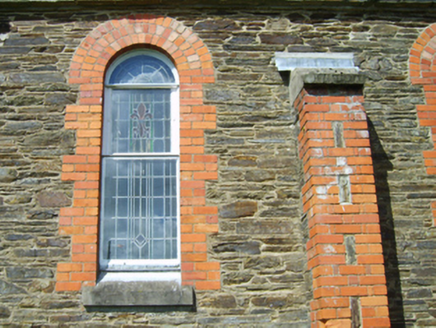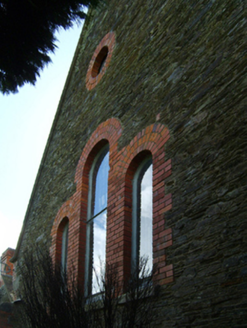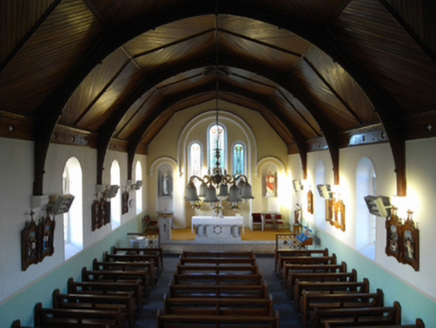Survey Data
Reg No
15610001
Rating
Regional
Categories of Special Interest
Architectural, Artistic, Historical, Social, Technical
Original Use
Church/chapel
In Use As
Church/chapel
Date
1910 - 1915
Coordinates
314648, 152211
Date Recorded
08/06/2007
Date Updated
--/--/--
Description
Detached six-bay double-height single-cell Catholic church, designed 1911; built 1912-3; dedicated 1913, on a rectangular plan with single-bay full-height buttressed gabled breakfront to entrance (south) front. "Restored", 1990, with sanctuary reordered. Rededicated, 1991. Pitched slate roof with trefoil-perforated crested terracotta ridge tiles, concrete coping to gables on rendered ogee corbel kneelers including concrete coping to gable to entrance (south) front on rendered ogee corbel kneelers with rendered gabled bellcote to apex framing cast-bronze bell, and replacement uPVC rainwater goods on timber eaves boards on slate flagged rubble stone eaves retaining some cast-iron square profile downpipes. Rendered walls to entrance (south) front on rendered plinth with rendered clasping buttresses to corners having concrete ogee coping; coursed rubble stone surface finish (remainder) with red brick buttresses having concrete ogee coping. Round-headed window openings with dragged concrete sills, and red brick block-and-start surrounds framing storm glazing over fixed-pane fittings having margins centred on stained glass "Fleurs-de-Lys". Round-headed "Trinity Window" to chancel (north) with concrete sills, and red brick block-and-start surrounds framing storm glazing over fixed-pane fittings having margins centred on leaded stained glass panels. Round-headed door opening to entrance (south) front with concrete threshold, concealed dressings having moulded reveals with hood moulding over on label stops framing timber boarded or tongue-and-groove timber panelled double doors. Round-headed flanking window openings with concrete sills, and concealed dressings framing storm glazing over fixed-pane fittings having margins centred on stained glass "Fleurs-de-Lys". Interior including vestibule (south); square-headed door opening into nave with glazed timber panelled double doors having overlight; full-height interior with timber panelled choir gallery (south), carpeted aisles between Maltese Cross-detailed timber pews, paired Gothic-style timber stations between frosted glass windows, encaustic tiled stepped dais to sanctuary (north) reordered, 1990, with hexafoil-panelled cut-veined white marble altar below stained glass "Trinity Window" (1913), and exposed round arch braced timber roof construction on "Cavetto"-detailed corbels with diagonal timber boarded or tongue-and-groove timber panelled polygonal vaulted ceiling in carved timber frame on carved timber cornice on quatrefoil-perforated frieze. Set in landscaped grounds with cruciform-detailed rendered panelled piers to perimeter having pedimented capping supporting wrought iron-detailed cast-iron double gates.
Appraisal
A church erected to a competition-winning design (1911) by George Luke O'Connor (d. 1947) of Great Brunswick Street [Pearse Street], Dublin (Irish Builder 1913, 287), representing an integral component of the early twentieth-century ecclesiastical heritage of north County Wexford with the architectural value of the composition, one succeeding an incomplete church (1840-6) aborted at the outbreak of the Great Famine (1845-9; de Vál 2004, 48), confirmed by such attributes as the rectilinear "barn" plan form, aligned along a liturgically-correct axis; the slender profile of the openings underpinning a streamlined Romanesque theme with the chancel defined by an elegant "Trinity Window"; and the handsome bellcote embellishing the roofline as a picturesque eye-catcher in the landscape. Having been well maintained, the elementary form and massing survive intact together with substantial quantities of the original fabric, both to the exterior and to the vaulted interior reordered (1990) in accordance with the liturgical reforms sanctioned by the Second Ecumenical Council of the Vatican (1962-5) where contemporary joinery; restrained stained glass; and a much-modified high altar, all highlight the modest artistic potential of the composition: meanwhile, an exposed timber roof construction pinpoints the engineering or technical dexterity of a church making a pleasing visual statement in a rural village street scene.
